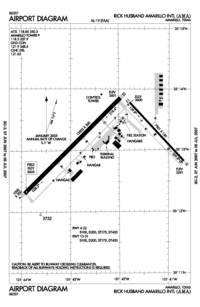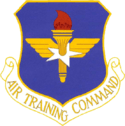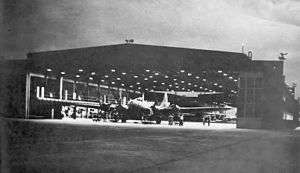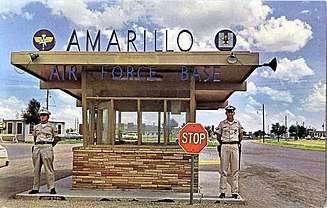Rick Husband Amarillo International Airport
Rick Husband Amarillo International Airport (IATA: AMA, ICAO: KAMA, FAA LID: AMA) is a public airport six miles (10 km) east of downtown Amarillo, in Potter and Randall Counties, Texas, United States.[2] The airport was renamed in 2003 after NASA astronaut and Amarillo native Rick Husband, who died in the Space Shuttle Columbia disaster in February of that year.
Rick Husband Amarillo International Airport | |||||||||||||||
|---|---|---|---|---|---|---|---|---|---|---|---|---|---|---|---|
 | |||||||||||||||
| Summary | |||||||||||||||
| Airport type | Public | ||||||||||||||
| Owner | City of Amarillo | ||||||||||||||
| Operator | Amarillo Airport Department | ||||||||||||||
| Serves | Amarillo, Texas | ||||||||||||||
| Elevation AMSL | 3,607 ft / 1,099.4 m | ||||||||||||||
| Coordinates | 35°13′10″N 101°42′21″W | ||||||||||||||
| Website | http://airport.amarillo.gov | ||||||||||||||
| Map | |||||||||||||||
 AMA Location of airport in Texas/United States  AMA AMA (the United States) | |||||||||||||||
| Runways | |||||||||||||||
| |||||||||||||||
| Statistics (2018, 2018, 2016) | |||||||||||||||
| |||||||||||||||
| Amarillo Air Force Base Amarillo Army Airfield   | |
|---|---|
| Part of Strategic Air Command/Air Training Command | |
| Amarillo, Texas | |
| Type | Air Force Base |
| Site history | |
| Built | 1942 |
| Built by | United States Army Air Forces |
| In use | 1942–1946,1951-1968 |
History
Early Years
The first recorded landing of aircraft in Amarillo occurred on 27 April 1918, when two Army Signal Corps planes, commanded by a Lt. R. Gray, landed in a pasture located in the 500 block of N. Polk. They refueled at the corner of NE 4th and N. Polk, before taking off again. In 1919, pilot-mechanics Fred w. Hinds and Jack Hiller, stationed at Call Field, flew W.K. Whipple to the same pasture. Whipple met with Porter Whaley, the head of Amarillo's Board of City Development, about starting an aviation company. The result was the Panhandle Air Service and Transportation Co.[3]
Panhandle Aerial Service and Transportation Co. was based at Amarillo's first aerodrome, Bivins Field, which started operation on 1 Jan. 1920. Located in the Bivins Addition of southwest Amarillo, the two runways now form North and South Julian Boulevard. The company was financed by H.E. Fuqua and Lee Bivins, which included building a $30,000 six-plane hangar located near 15th and Crockett. The operation eventually moved to the north of Amarillo, west of the current Ross Rogers Municipal Golf Course. In 1928, the field was renamed Bivins-English Field, when Harold English took over management.[3][4]
The City of Amarillo opened a municipal airport, referred to as "Old Muny" or "Old Municipal Airport", on 29 May 1929, located 4 miles west of the current Amarillo International Airport. Transcontinental air service was inaugurated here on 7 July 1929. Charles Lindbergh and wife were in attendance. Old Muny closed in 1951.[3][5]
Also in 1929, Bivins-English Field was relocated further 7 miles east of Amarillo on Highway 60, and renamed English Field. Amarillo Airport Corporation, formed by Harold English and Thornton Oxnard, had bought out Lee Bivins' interest. Western Air Express moved operations from Old Muny to English Field in 1930. Southern Air Transport soon followed. By 1937, TWA and Braniff were also operating from English Field. However, that winter, a fire destroyed the hangar, administration building, and cafe. Operations continued though, and English Field was rebuilt between in 1939–43, which included paved runways and taxiways when the city took over in 1941.[3][5]
Passenger airline service
Harold English opened English Field in 1929. That year Transcontinental & Western Air began passenger airline service to Amarillo. In 1931, Amarillo was a stop on coast-to-coast service between Los Angeles and New York City operated by Transcontinental & Western Air with Ford Trimotor aircraft.[6] The airline's timetable stated this transcontinental flight could be accomplished in 36 hours with "overnight hotel stops" being made in each direction on a routing of Los Angeles – Kingman, Ariz. – Winslow, Ariz. – Albuquerque – Amarillo – Wichita – Kansas City – St. Louis – Indianapolis – Columbus, Ohio – Pittsburgh – Philadelphia – New York City (via Newark Airport). Transcontinental & Western Air (TWA) eventually changed its name to Trans World Airlines, which, in turn, continued to serve Amarillo for many years.
In later years, Braniff International, Central Airlines and successor Frontier Airlines (1950–1986), as well as Continental Airlines began serving Amarillo. The April 1957 Official Airline Guide (OAG) lists 23 weekday departures: eleven on Braniff, eight on TWA, two on Central and two on Continental. Trans-Texas Airways (TTa, which was subsequently renamed Texas International) also then began serving the airport. Trans World Airlines operated flights to Wichita, Kansas City, St. Louis, Chicago, Albuquerque, Las Vegas, and Los Angeles. In 1960, TWA was operating all of its flights into Amarillo with Lockheed Constellation propliners.[7] By 1961, Continental was serving the airport with British-manufactured Vickers Viscount turboprops flying Amarillo – Lubbock – Dallas Love Field as well as Amarillo – Lubbock – Midland/Odessa – San Angelo – Austin – Houston Hobby Airport service.[8] In 1966, Braniff was operating Lockheed L-188 Electra turboprop service nonstop (and also direct via Lubbock) to Dallas Love Field, as well as direct to Denver via Colorado Springs.[9] By 1967, Braniff in cooperation with Eastern Airlines were operating interchange thru plane Electra propjet service between Atlanta and Denver via Amarillo on a daily round trip routing of Atlanta – Birmingham – Memphis – Little Rock – Tulsa – Oklahoma City – Amarillo – Denver.[10] Also in 1967, Central Airlines was serving Amarillo with Douglas DC-3 prop aircraft and Convair 600 turboprops on direct services to Borger, Texas, Denver, Kansas City, Liberal, Kansas, Oklahoma City, Pueblo, Colorado, Topeka and Wichita.[11] Following its acquisition of and merger with Central, Frontier Airlines operated Convair 580 turboprops to Denver and Memphis via intermediate stops at various destinations in Colorado, Oklahoma, and Arkansas. Trans-Texas Airways began serving the airport during the mid 1960s with Convair 240 propeller aircraft flying Amarillo – Lubbock – Abilene – Austin – Houston Hobby Airport service.[12]
The first scheduled jet service into Amarillo was flown by Trans World Airlines in 1964. By 1966, TWA was serving the airport with Boeing 727-100 and Convair 880 jetliners with nonstop flights to Albuquerque and Wichita, and direct, no change of plane jet service to Kansas City, Los Angeles, New York LaGuardia Airport, Pittsburgh, St. Louis and San Francisco.[13] In 1967, TWA was flying nonstop Boeing 727 service from Amarillo to LAX. By 1983, TWA had ceased all flights into the airport thus ending over 50 years of passenger service at Amarillo.[14]
By 1968, Braniff International had introduced jet service into the airport with Boeing 727-100 and British Aircraft Corporation BAC One-Eleven jets. At this time, Braniff was operating nonstop 727 flights to Denver and also direct to Dallas Love Field (DAL) via a stop in Lubbock in addition to flying daily nonstops to DAL with the BAC One-Eleven twin jet and also operating a daily BAC One-Eleven service on a routing of Amarillo - Oklahoma City - Tulsa - Fort Smith, AR - Little Rock - Memphis.[15] Braniff later operated nonstop Boeing 727-100 and Boeing 727-200 flights from the airport to Dallas/Fort Worth International Airport (DFW).[16] Continental also began jet service and in 1971 was operating Boeing 727-200 and Douglas DC-9-10 flights with routings of Amarillo - Lubbock - Dallas Love Field; Amarillo - Lubbock - Midland/Odessa-Houston Intercontinental Airport and Amarillo - Lubbock - Midland/Odessa - El Paso - Los Angeles (LAX).[17] Continental would subsequently end its Amarillo service but would then return in 1982 when the airline merged with Texas International.
By 1978, Texas International was operating Douglas DC-9-10 and McDonnell Douglas DC-9-30 jets into the airport on nonstop flights to Dallas/Fort Worth, Denver, San Antonio and Lubbock with direct one stop DC-9 service to Austin and Houston Intercontinental Airport (IAH) as well as no change of plane multi-stop flights to Corpus Christi, McAllen, TX and Beaumont/Port Arthur, TX.[18] Also in 1978, Southwest Airlines began operating nonstop Boeing 737-200 service to Dallas Love Field.[19] Other airlines operating mainline jet service into the airport in the past included American Airlines with Boeing 727-100, Boeing 727-200, Fokker 100 and McDonnell Douglas MD-80 nonstops to Dallas/Fort Worth,[20] Continental Airlines (following its merger with Texas International in 1982) with Douglas DC-9-10 and McDonnell Douglas DC-9-30 nonstops to Austin and Denver as well as one stop DC-9 service to Houston Intercontinental[21] and Delta Air Lines with Boeing 737-200 nonstops to Dallas/Fort Worth.[22] Aspen Airways also operated jet service into Amarillo in the past with British Aerospace BAe 146-100 aircraft flying both independently and later as United Express with nonstop flights to Denver.[23]
Airline terminal and airport name change
In 1952 the airport name changed to Amarillo Air Terminal. After the adjacent Amarillo Air Force Base was deactivated in 1968 a portion became part of Amarillo Air Terminal. The primary instrument runway, built for the USAF Strategic Air Command base, at 13,502 feet (4,115 m) is among the longest commercial runways in the United States and is still used for military training. During the mid-1970s the airport was used for jet training by (then) West German national airline Deutsche Lufthansa AG.[24]
New terminal buildings were opened on 12 Sept. 1954, and 17 May 1971. By 1976, the airport had also become a Port of entry, becoming Amarillo International Airport.[3]
The original English Field terminal building was converted in 1997 to a museum maintained by the Texas Aviation Historical Society. This museum lost its lease with the City of Amarillo and is now located in buildings southeast of the main runway, formally known as Attebury Grain.[25] The name of the original airfield is memorialized in the English Fieldhouse, a local restaurant located adjacent to the general aviation terminal.
In 2003 the airport terminal building was rededicated to NASA astronaut Rick Husband, the commander of mission STS-107 of the Space Shuttle Columbia and an Amarillo native. Husband and his crew were killed when the Columbia disintegrated upon re-entry on February 1, 2003.
The terminal building underwent a $52.2 million renovation that was designed by the firms Reynolds, Smith & Hills and Shiver Megert and Associates and completed in 2011.[26]
Amarillo Field/Amarillo Army Airfield (1942–1946)

In the midst of WW II, Col. Edward C. Black was transferred from his command of Sheppard Field, and ordered to activate an Air Corp Technical School ten miles east of Amarillo, next to English Field. The purpose of the center was to train Flying Fortress mechanics and technicians. Black established his headquarters in the Amarillo Building and construction started on 20 April. The new site was designated Amarillo Field on 26 May. Over 25,000 trees and shrubs were planted and grass sown in an attempt to control soil erosion and dust clouds. The field was manned on 2 Sept. students arrived on 3 Sept., Black's HQ staff moved in on 6 Sept., and instruction started on 7 Sept. Brig. Gen. Julian B. Haddon assumed command on 22 Oct. and held an open house for Amarillo residents on 11 Nov., Armistice Day, with over 40,000 attending. On 2 Dec. the name was changed to Amarillo Army Air Field. The first class of students graduated on 23 Dec., with Maj. Gen Jacob Fickel in attendance. Basic training was added in May 1943, training Army Air Forces personnel in the fundamentals of soldiering.[27]:12–14[28]:40
Though most students entered the training without any mechanical training, but the 76 day primary course followed by a 36-day specific course, ensured they were experts upon graduating. Classes were in session around the clock. Students became familiar with mechanics tools, and the structure of the B-17, which included a B-17 cutaway, and a complete B-17 composed of parts from five different previously scrapped airplanes. In addition, aircraft instruments, hydraulic systems, electrical systems, aircraft engines, and fuel systems repair and replacement are covered, including complete engine overhaul. This was in addition to regular military drill and calisthenics. Students were allowed one day off per week.[28][27]:12–14,18–22
B-29 flight engineer training started in 1944. This was the first AAF aircraft requiring such a crew member. The engine control panel was located behind the pilot, and the engineer adjusted the throttle, fuel mixture, supercharger, and propellor pitch for each engine. In addition, the flight engineer computed the aircraft range, fuel consumption, engine performance, weight and balance, and airworthiness. Aircraft mechanics were trained in either the B-29, or the B-17. After 10 May 1945, only B-29 training was offered.[28]:27,39
The base was established in April 1942 as a basic training centre and technical school for flight engineers as part of the Fourth Technical Training District and the first students began training there in September 1942.[29] In mid-October 1945 all training stations were transferred to the Eastern Technical Training Command which was redesignated Technical Training Command.[29]:33 The base was closed on 30 June 1946.[28]:339[3]:16-G
Amarillo Air Force Base (1951–1968)
With the start of the Korean War, the USAF turned to Amarillo once again as a location for technical training. On 1 March 1951 the Air Training Command activated Amarillo Air Force Base as a technical training base to provide jet airplane and engine mechanic training. The 3320th Technical Training Wing was established to oversee these training operations. Jet aircraft available for training mechanics included an F-89, an F-86F, and three B-47s.[28]:71–73,80,86–88,94,99–100,103–104,339
In 1958, Amarillo AFB offered a general course on guided missiles. On 1 Jan. 1959, the 3320th Technical Training Wing was redesignated as the Amarillo Technical Training Center, and on 15 July, a field training squadron was established. In 1961, base buildings were modernized, and in 1962, courses for the F/RF-4C were prepared. In 1964, a reserve medical unit was established at the base.[28]:107,110,115–116,121–122,129–130,135–136,142,143,146,150,154
In early 1965, ATC announced plans to close its training operations at Amarillo AFB, and transfer the base to the Air Defense Command. Amarillo's 29 technical courses would be transferred to other bases. However, emergency expansion of basic military training (BMT), as the result of the Vietnam War, meant the continued use of Amarillo as a training facility. Recruits began arriving on 18 Feb. 1966, and the 6-week BMT continued until Nov. 1968.[28]:157–158,160,162–163
On 10 Feb. 1966, an airman basic died from an outbreak of spinal meningitis at Lackland Air Force Base. As a consequence of the precautionary limited training at Lackland, ATC organized the 3330th Basic Military Training School, and assigned it to the Amarillo Training Technical Center as a second BMT school. However, the 3320th Retraining Group was relocated to Lowry AFB in 1967.[28]:162,168–170,173
On 5 January 1959, Strategic Air Command (SAC) established the 4128th Strategic Wing at Amarillo Air Force Base assigned it to the 47th Air Division.[30] In July 1959 the 4128th Strategic Wing was assigned to the 810th Air Division.[31] The wing became operational on 1 February 1960 when the 718th Bombardment Squadron, consisting of 15 B-52s moved to Amarillo. On 1 July 1962 the wing was reassigned to the 22d Air Division.[32] On 1 February 1963 the 4128th was replaced by reactivated 461st Bombardment Wing, Heavy (461st BW), which assumed its mission, personnel and equipment.[33]
The 461st Bombardment Wing was activated at Amarillo AFB on 1 Feb. 1963, absorbing the inactivated 4128th Strategic Wing. Trained to maintain heavy bombardment proficiency with the B-52, the wing maintained combat proficiency until 21 Jan. 1968, when the last B-52 was transferred. The 909th Air Refueling Squadron's KC-135s were assigned to the wing from 1 April 1963 until 25 June 1966. The wing's B-52's and crews participated in Operation Arc Light combat operations from 18 Jan. until 4 July 1967, while on a temporary duty assignment to Andersen Air Force Base. On 25 March 1968, the wing was inactivated. Wing commanders included Col. William R. Calhoun, Jr., Col. John B. Paine, Col. Charles D. Lewis, and Col. William H. Hill.[34]
Closure of the base was postponed from 30 June 1968 until the end of the year, while ATC released property. On 1 April, 1,784 acres and 7 buildings were released to the city of Amarillo. On 1 July facilities were released for civilian use, including those for Bell Helicopter, and Texas A&M University's technical training institute. Technical training courses ended on 27 Aug., and BMT ended on 11 Dec. Remaining Amarillo Technical Training Center functions ceased on 31 Dec. 1968, and the base was placed in inactive status on 1 Jan. 1969. The base was finally transferred to civilian control on 16 February 1971.[28]:174,186,339
Gen. William Lecel Lee served as the base commander from 1956 until 1962.[35]
Visits by NASA Shuttle Carrier Aircraft (SCA)
On July 1, 2007 the Space Shuttle Atlantis made a stop at the airport while being transported on top of the NASA Boeing 747 Shuttle Carrier Aircraft (SCA) from Edwards Air Force Base to Florida—one of the few visits by the shuttle to a commercial airport. After a brief stay it was flown on to Offutt Air Force Base. In 2009 the airport was again used as a refueling stop by the NASA Boeing 747 SCA. On September 20, the Space Shuttle Discovery was transported from Edwards Air Force Base to the Kennedy Space Center in Florida with stops in Amarillo, Carswell Air Force Base in Ft.Worth, and Barksdale Air Force Base in Louisiana.[36]
Facilities and aircraft
Rick Husband Amarillo International Airport covers 3,547 acres (1,435 ha) and has two concrete runways: 4/22 is 13,502 ft × 200 ft (4,115 m × 61 m) and 13/31 is 7,901 ft × 150 ft (2,408 m × 46 m).[2] In the year ending July 31, 2018, the airport had 68,367 aircraft operations, average 187 per day: 40% military, 37% general aviation, 11% air taxi and 12% scheduled commercial. At the time there were 45 aircraft based at this airport: 21 single-engine, 15 multi-engine, 8 jet and 1 helicopter.[2] Leading Edge Corporation has an aircraft painting facility located on the airport; many American Airlines and United Airlines jetliners are painted there.
Airlines and destinations
| Airlines | Destinations | Refs |
|---|---|---|
| American Eagle | Dallas/Fort Worth | [37] |
| Southwest Airlines | Dallas–Love, Houston–Hobby, Las Vegas | [38] |
| United Express | Denver, Houston–Intercontinental | [39] |
| Destinations map |
|---|
Destinations from Rick Husband Amarillo International Airport |
Top destinations
| Rank | City | Passengers | Carriers |
|---|---|---|---|
| 1 | Dallas–Love, TX | 130,000 | Southwest |
| 2 | Dallas/Fort Worth, TX | 116,000 | American |
| 3 | Houston, TX (IAH) | 34,000 | United |
| 4 | Las Vegas, NV | 32,000 | Southwest |
| 5 | Denver, CO | 25,000 | United |
| 7 | Houston, TX (HOU) | 3,000 | Southwest |
References
![]()
- "Amarillo Globe-News". Retrieved July 15, 2017.
- FAA Airport Master Record for AMA (Form 5010 PDF), effective Nov 10, 2016.
- Eaves, Delbert (18 January 1976). "Amarillo's Air History Started 58 Years Ago". Sunday News-Globe. Retrieved 3 November 2018.
- Archer, Jeanne; Taras, Stephanie (2009). Touching Lives: The Lasting Legacy of the Bivins Family. Tell Studios Inc. pp. 83–85. ISBN 9780974914862.
- Price, Byron (1986). The Golden Spread. Windsor Publications, Inc. p. 92. ISBN 0897811836.
- http://www.timetableimages.com, Feb. 1, 1931 TWA system timetable
- http://www.timetableimages.com, April 24, 1960 TWA system timetable
- http://www.timetableimages.com, April 30, 1961 Continental Airlines system timetable
- http://www.timetableimages.com, April 24, 1966 Braniff International system timetable
- http://www.timetableimages.com, June 13, 1967 Eastern Airlines system timetable
- http://www.timetablemages.com%5B%5D, July 1, 1967 Central Airlines system timetable
- http://www.timetableimages.com, Oct. 30, 1966 Trans-Texas Airways system timetable
- http://www.timetableimages.com, May 23, 1966 TWA system timetable
- http://www.departedflights.com, July 1, 1983 TWA route map
- http://www.timetableimages.com, July 1, 1968 Braniff International system timetable
- http://www.departedflights.com, Nov. 15, 1979 & April 1, 1981 editions, Official Airline Guide (OAG), Amarillo flight schedules
- http://www.departedflights.com, Oct. 3, 1971 Continental Airlines system timetable.
- http://www.departedflights.com, Mar. 15, 1978 Texas International system timetable
- https://tshaonline.org/handbook/online/articles/eps01 TSHA Online - Texas State Historical Association
- https://www.departedflights.com Archived 2017-09-12 at the Wayback Machine, June 1, 1983, April 2, 1995 & June 1, 1999 editions, Official Airline Guide (OAG), Amarillo flight schedules
- http://www.departedflights.com, July 1, 1983 Official Airline Guide (OAG), Amarillo flight schedules
- http://www.departedflights.com, July 1, 1991 Official Airline Guide (OAG), Amarillo flight schedules
- http://www.departedflights.com, Feb. 15, 1985 Official Airline Guide (OAG), Amarillo flight schedules
- Warnecke, Ann. "Amarillo Voices: Journal is worth much more than a thousand words - Amarillo.com - Amarillo Globe-News". amarillo.com. Archived from the original on 2015-04-14.
- "Board asks for English Field lease extension". Amarillo Globe News. June 29, 2004. Archived from the original on September 29, 2007.
- "Amarillo Int'l Unveils Clearly Upgraded Terminal". Archived from the original on 2014-10-07. Retrieved 2012-06-04.
- 409th Technical School Squadron (1943). Amarillo Army Air Field, 409th Technical School Squadron, Army Air Forces Training Command (PDF). Baton Rouge: Army and Navy Publishing Company of Louisiana.
- Manning, Thomas; Ashcroft, Bruce; Emmons, Richard; Hussey, Ann; Mason, Joseph (2005). History of Air Education and Training Command, 1942-2002. Randolph AFB: Office of History and Research, Headquarters, Air Education and Training Command. p. 18, 39,339.
- Manning, Thomas (2005). History of Air Education and Training Command, 1942–2002. Office of History and Research, Headquarters, AETC, Randolph AFB, Texas. p. 18. ASIN B000NYX3PC.
- "Factsheet 47 Air Division". Air Force Historical Research Agency. 10 May 2007. Archived from the original on 17 October 2012. Retrieved 17 January 2018.
- "Factsheet 810 Strategic Aerospace Division". Air Force Historical Research Agency. 10 November 2007. Archived from the original on 30 October 2012. Retrieved 17 January 2018.
- "Factsheet 22 Air Division". Air Force Historical Research Agency. 10 May 2007. Archived from the original on 24 October 2012. Retrieved 17 January 2018.
- Ravenstein, Charles A. (1984). Air Force Combat Wings, Lineage & Honors Histories 1947-1977. Office of Air Force History. pp. 255–6. ISBN 0912799129.
- Ravenstein, Charles (1984). Air Force Combat Wings, Lineage and Honors Histories, 1947-1977. Washington D.C.: Office of Air Force History, USAF. pp. 254–255. ISBN 0912799129.
- "Lee, William Lecel: Papers 1927-69" (PDF). Dwight D. Eisenhower Library. Retrieved 3 November 2018.
- Beilue, Jon Mark (2011). "Visits reminders of Amarillo's special link to NASA". amarillo.com. Amarillo Globe News. Retrieved 6 November 2018.
- "Flight schedules and notifications". Retrieved October 28, 2019.
- "Check Flight Schedules". Retrieved January 4, 2019.
- "Timetable". Retrieved January 4, 2019.
- http://www.transtats.bts.gov/airports.asp?pn=1&Airport=AMA&Airport_Name=Amarillo,%20TX:%20Amarillo%20Airport&carrier=FACTS
External links
| Wikimedia Commons has media related to Amarillo Air Force Base. |
- FAA Airport Diagram (PDF), effective August 13, 2020
- FAA Terminal Procedures for AMA, effective August 13, 2020
- Resources for this airport:
- AirNav airport information for KAMA
- ASN accident history for AMA
- FlightAware airport information and live flight tracker
- NOAA/NWS weather observations: current, past three days
- SkyVector aeronautical chart for KAMA
- FAA current AMA delay information



